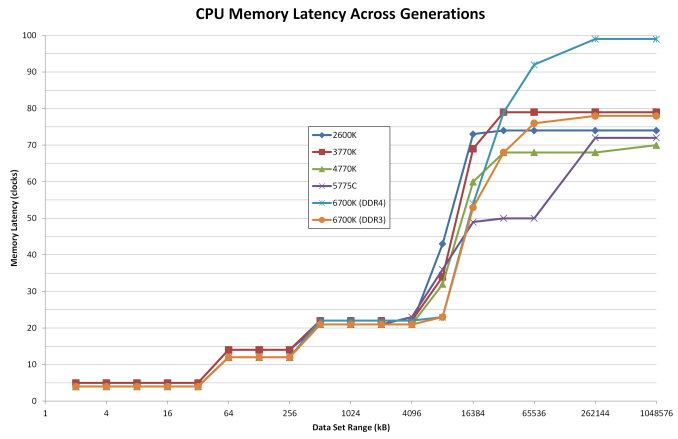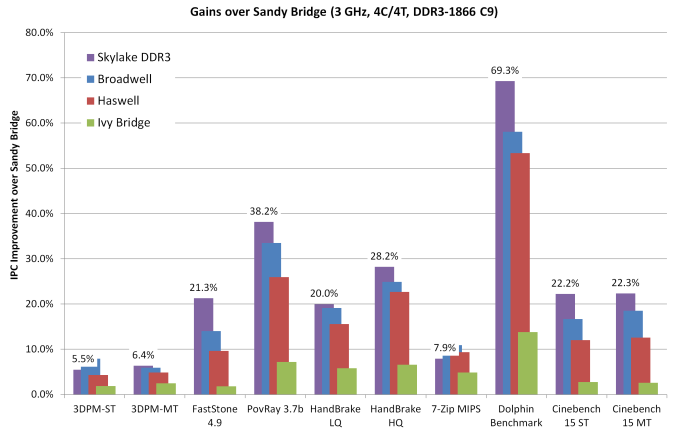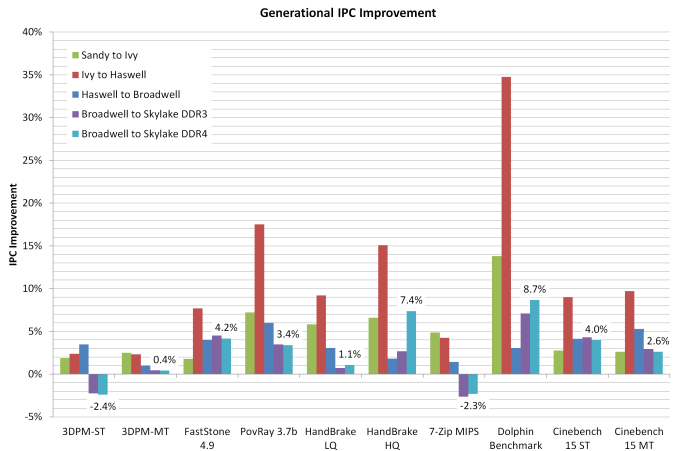The Intel 6th Gen Skylake Review: Core i7-6700K and i5-6600K Tested
by Ian Cutress on August 5, 2015 8:00 AM ESTComparing IPC on Skylake: Memory Latency and CPU Benchmarks
The following explanation of IPC has been previously used in our Broadwell review.
Being able to do more with less, in the processor space, allows both the task to be completed quicker and often for less power. While the concept of having devices with multiple cores has allowed many programs to run at once, purely parallel compute such as graphics and most things to run faster, we are all still limited by the fact that a lot of software is still relying on one line of code after another. This is referred to as the serial part of the software, and is the basis for many early programming classes – getting the software to compile and complete is more important than speed. But the truth is that having a few fast cores helps more than several thousand super slow cores. This is where IPC comes in to play.
The principles behind extracting IPC are quite complex as one might imagine. Ideally every instruction a CPU gets should be read, executed and finished in one cycle, however that is never the case. The processor has to take the instruction, decode the instruction, gather the data (depends on where the data is), perform work on the data, then decide what to do with the result. Moving has never been more complicated, and the ability for a processor to hide latency, pre-prepare data by predicting future events or keeping hold of previous events for potential future use is all part of the plan. All the meanwhile there is an external focus on making sure power consumption is low and the frequency of the processor can scale depending on what the target device actually is.
For the most part, Intel has successfully increased IPC every generation of processor. In most cases, 5-10% with a node change and 5-25% with an architecture change with the most recent large jumps being with the Core architecture and the Sandy Bridge architectures, ushering in new waves of super-fast computational power. As Broadwell to Skylake is an architecture change with what should be large updates, we should expect some good gains.
| Intel Desktop Processor Cache Comparison | |||||
| L1-D | L1-I | L2 | L3 | L4 | |
| Sandy Bridge i7 | 4 x 32 KB | 4 x 32 KB | 4 x 256 KB | 8 MB | |
| Ivy Bridge i7 | 4 x 32 KB | 4 x 32 KB | 4 x 256 KB | 8 MB | |
| Haswell i7 | 4 x 32 KB | 4 x 32 KB | 4 x 256 KB | 8 MB | |
| Broadwell i7 (Desktop / Iris Pro 6200) |
4 x 32 KB | 4 x 32 KB | 4 x 256 KB | 6 MB | 128 MB eDRAM |
| Skylake i7 | 4 x 32 KB | 4 x 32 KB | 4 x 256 KB | 8 MB | |
For this test we took Intel’s most recent high-end i7 processors from the last five generations and set them to 3.0 GHz and with HyperThreading disabled. As each platform uses DDR3, we set the memory across each to DDR3-1866 with a CAS latency of 9. For Skylake we also run at DDR4-2133 C15 as a default speed. From a pure cache standpoint, here is how each of the processors performed:
If we ignore Broadwell and its eDRAM, the purple line, especially from 16MB to 128MB, both of the lines for Skylake stay at the low latencies until 4MB. Between 4MB and 8MB, the cache latency still seems to be substantially lower than that of the previous generations.
Normally in this test, despite all of the CPUs having 8MB of L3 cache, the 8MB test has to spill out to main memory because some of the cache is already filled. If you have a more efficient caching and pre-fetch algorithm here, then the latency ‘at 8MB’ will be lower. So an update for Skylake, as shown in both the DDR4 and DDR3 results, is that the L3 caching algorithms or hardware resources have been upgraded.
At this point I would also compare the DDR3 to DDR4 results on Skylake above 16MB. It seems that the latency in this region is a lot higher than the others, showing nearly 100 clocks as we move up to 1GB. But it is worth remembering that these tests are against a memory clock of 2133 MHz, whereas the others are at 1866 MHz. As a result, the two lines are more or less equal in terms of absolute time, as we would expect.
Here are the generational CPU results at 3.0 GHz:
Dolphin Benchmark: link
Many emulators are often bound by single thread CPU performance, and general reports tended to suggest that Haswell provided a significant boost to emulator performance. This benchmark runs a Wii program that raytraces a complex 3D scene inside the Dolphin Wii emulator. Performance on this benchmark is a good proxy of the speed of Dolphin CPU emulation, which is an intensive single core task using most aspects of a CPU. Results are given in minutes, where the Wii itself scores 17.53 minutes.

Cinebench R15
Cinebench is a benchmark based around Cinema 4D, and is fairly well known among enthusiasts for stressing the CPU for a provided workload. Results are given as a score, where higher is better.


Point Calculations – 3D Movement Algorithm Test: link
3DPM is a self-penned benchmark, taking basic 3D movement algorithms used in Brownian Motion simulations and testing them for speed. High floating point performance, MHz and IPC wins in the single thread version, whereas the multithread version has to handle the threads and loves more cores. For a brief explanation of the platform agnostic coding behind this benchmark, see my forum post here.


Compression – WinRAR 5.0.1: link
Our WinRAR test from 2013 is updated to the latest version of WinRAR at the start of 2014. We compress a set of 2867 files across 320 folders totaling 1.52 GB in size – 95% of these files are small typical website files, and the rest (90% of the size) are small 30 second 720p videos.

Image Manipulation – FastStone Image Viewer 4.9: link
Similarly to WinRAR, the FastStone test us updated for 2014 to the latest version. FastStone is the program I use to perform quick or bulk actions on images, such as resizing, adjusting for color and cropping. In our test we take a series of 170 images in various sizes and formats and convert them all into 640x480 .gif files, maintaining the aspect ratio. FastStone does not use multithreading for this test, and thus single threaded performance is often the winner.

Video Conversion – Handbrake v0.9.9: link
Handbrake is a media conversion tool that was initially designed to help DVD ISOs and Video CDs into more common video formats. The principle today is still the same, primarily as an output for H.264 + AAC/MP3 audio within an MKV container. In our test we use the same videos as in the Xilisoft test, and results are given in frames per second.


Rendering – PovRay 3.7: link
The Persistence of Vision RayTracer, or PovRay, is a freeware package for as the name suggests, ray tracing. It is a pure renderer, rather than modeling software, but the latest beta version contains a handy benchmark for stressing all processing threads on a platform. We have been using this test in motherboard reviews to test memory stability at various CPU speeds to good effect – if it passes the test, the IMC in the CPU is stable for a given CPU speed. As a CPU test, it runs for approximately 2-3 minutes on high end platforms.

Synthetic – 7-Zip 9.2: link
As an open source compression tool, 7-Zip is a popular tool for making sets of files easier to handle and transfer. The software offers up its own benchmark, to which we report the result.

Overall: CPU IPC
Removing WinRAR as a benchmark because it gets boosted by the eDRAM in Broadwell, we get an interesting look at how each generation has evolved over time. Taking Sandy Bridge (i7-2600K) as the base, we have the following:
From a pure upgrade perspective, the IPC gain here for Skylake does not look great. In fact in two benchmarks the IPC seems to have decreased – 3DPM in single thread mode and 7-ZIP. What makes 3DPM interesting is that the multithread version still has some improvement at least, if only minor. This difference between MT and ST is more nuanced than first appearances suggest. Throughout the testing, it was noticeable that multithreaded results seem to (on average) get a better kick out of the IPC gain than single threaded. If this is true, it would suggest that Intel has somehow improved its thread scheduler or offered new internal hardware to deal with thread management. We’ll probably find out more at IDF later in the year.
If we adjust this graph to show generation to generation improvement and include the DDR4 results:
This graph shows that:
Sandy Bridge to Ivy Bridge: Average ~5.8% Up
Ivy Bridge to Haswell: Average ~11.2% Up
Haswell to Broadwell: Average ~3.3% Up
Broadwell to Skylake (DDR3): Average ~2.4% Up
Broadwell to Skylake (DDR4): Average ~2.7% Up
Oh dear. Typically with an architecture update we see a bigger increase in performance than 2.7% IPC. Looking at matters purely from this perspective, Skylake does not come out well. These results suggest that Skylake is merely another minor upgrade in the performance metrics, and that a clock for clock result compared to Broadwell is not favorable. However, consider that very few people actually invested in Broadwell. If anything, Haswell was the last major mainstream processor generation that people actually purchased, which means that:
Haswell to Skylake (DDR3): Average ~5.7% Up.
This is more of a bearable increase, and it takes advantage of the fact that Broadwell on the desktop was a niche focused launch. The other results in the review will be interesting to see.













477 Comments
View All Comments
ES_Revenge - Friday, August 14, 2015 - link
Umm what the heck happened to the power consumption? In particular the i7/6700K. It's not really shown thoroughly in this review but the Broadwell CPUs are more power-efficient it seems. While the 6700K has a half GHz faster clock speed, it also has a much lesser GPU. To begin with, both the i5 and i7 Skylake parts have higher TDPs than the Broadwell desktop parts, and then the 6700K can actually draw over 100W when loaded. This is above its TDP and also significantly more than its 6600K counterpart which runs only a few hundred MHz slower. Odd.I mean I think we were all waiting for a desktop CPU that didn't have the power constraints as the Broadwell CPUs did but I don't think this is exactly what anyone was expecting. It's like these Skylake CPUs don't just take more power but they do so...for no reason at all. Sure they're faster but not hugely so; and, again, their iGPUs are significantly slower than Broadwell's. So their slight speed advantage came at the price of markedly increased power consumption over the previous gen.
That only leads me to the question--WTF? lol What happened here with the power consumption? And losing that IVR didn't seem to help anything, eh? Skylake is fast and all but TBH I was more impressed *overall* with Broadwell (and those CPUs you can't even find for sale anywhere, the last time I checked--a few weeks ago). Granted as we've seen in 2nd part of the Broadwell review it's not a stellar OCer but still, overall it seems better to me than Skylake.
It's kind of funny because when Broadwell DT launched I was thinking of how "Intel is mainly focusing on power consumption these days", meaning I thought they weren't focused enough on performance of DT CPUs. But it seems they've just thrown that out the window but the performance isn't anything *spectacular* from these CPUs, so it just seems like a step backwards. It's like with Broadwell they were showing just how much performance they could do with both CPU and iGPU with a minimum of power consumption--and the result was impressive. Here it's like they just forgot about that and said "It's Skylake...it's new and better! Everyone buy it!" Not really that impressive.
janolsen - Friday, August 14, 2015 - link
Stupid question:Can Skylake IGP easily play back 4K video. Thinking of a person just using a 4K screen for Youtube stuff, not gaming...
ES_Revenge - Saturday, August 15, 2015 - link
Yeah it can. This one of the very few improvements over Broadwell/previous HD Graphics implementations. It has a "full" HEVC decode solution built in, unlike the "hybrid" solutions they had previously. If you look on the 4th page of the review it actually goes pretty in-depth about this (not sure how you missed that?).alacard - Friday, August 14, 2015 - link
It's clear you put a ton of work into this Ian, many thanks.Flash13 - Monday, August 17, 2015 - link
So, far Intel Core i7-6700K 8M Skylake Quad-Core 4.0GHz is just vapor to the public.somatzu - Wednesday, August 19, 2015 - link
"So where'd you get your degree?""Anandtech comments section."
superjim - Friday, August 21, 2015 - link
I'm still not convinced this is a worthwhile upgrade from Sandy Bridge. If I can get 4.8 from a 2700K and maybe 4.6 from a 6700k, factor in cost difference, is it really worth it? At the end of the day, cpu/mobo/ram would be near $700 for maybe a 15% speed bump overall.watzupken - Friday, September 4, 2015 - link
From a desktop standpoint, there is very little incentive for one to upgrade. The new gen mainly targets power savings, so likely to benefit mobile users, i.e. Ultra Books and tablets.As far as Intel is trying to target those people still on Sandy and Ivy Bridge to upgrade, they fail to account for the cost of upgrade for a paltry improvement in performance. To upgrade from SB, one has to upgrade the ram, motherboard and CPU, and on top of that, need to separately purchase a heatsink since they want to cut cost.
CynicalCyanide - Saturday, August 22, 2015 - link
Question to the Authors: You've noted two DDR4 equipped mobos in the "Test Setup" section, but you've also tested DDR3 equipped Skylake. Which motherboard did you use for that?Furthermore, in a previous article it was mentioned that Z170 wouldn't be able to handle 'regular' 1.5V DDR3, but here apparently it wasn't an issue reusing old 1.5V RAM after a voltage adjustment. Was there any special method required aside from booting as per normal into the BIOS and adjusting the voltage?
TiberiuC - Saturday, August 22, 2015 - link
Everything comes down eventualy to "Intel vs AMD". What Intel did with Core2Duo was the right path to go, what AMD did was so wrong and that sometimes happen when you inovate. AMD stopped with the last FX series and went back to the drawing board and that is a wise decision. What will ZEN do? i am expecting Ivi Bridge performance maybe touching haswell here and there. If this wont happen, it is bad for them and very bad for us. Intel is starting to milk the customers acting like there is a monopoly. I did buy my 2600k for 300$ (after rebates), i have to say that the price of the 6700k is well, meh...